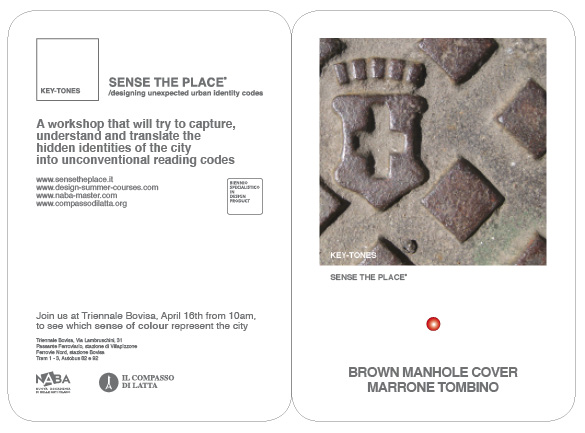_FOREWORD
The “SENSE THE PLACE” series of Workshops was part of a project to start a two year specialization course in Product Design at the “Nuova Accademia di Belle Arti” (NABA) (New Academy of Fine Arts) that took place between 2009-11. Initially the intention was for these workshops to be an observatory for the city of Milan in light of the 2015 Expo and then become a FORMAT for colour coding cities in other countries. These workshops adopt the design philosophy of the course which makes use of Design as a process and research as a mechanism for investigation to collect and process cultural content in cognitive maps.
This platform, which is an INTERSEZIONI‘s format, serves as an opportunity to bring together professionals, students, researcher, architect and designer in order to start a dialogue and a series of cultural reflections that will then be broadcast and distributed through blogs and publications.
MA in Design Product at NABA 2009-11
Introduction: the multidisciplinarity of contemporary design
The classic definition of design as a discipline tied to objects and to the intuition of the single designer that develops “the object” together with the visionary entrepreneur is now outdated.
Design was redefined according to the complex dynamics of an evolving society, which learnt to consume and use not just objects, but entire families of products and services tied to the objects themselves.
Nowadays, to design means to be aware of and take into consideration complex processes that tie products to services. Those processes meet the requirements and behaviors – less and less conventional ones – of fast-paced communities used to fast changes, very long or extremely short days, changing and never linear modes.
The relationship between creator (who designs) and producer (who produces) was reconfigured in a wide design environment that often involves actors that are internal or external to the company, with the common objective of interpreting users needs and translate them into actual ideas and experiences.
The product is now part of a wider vision, including all the modalities a company uses to communicate and represent itself. Its image, recognizability, and brand appearance, are expressed in the product as the values that lead people to recognize themselves with a specific brand and identify in it behavioral systems they long for.
Starting from Design as a multidiscipline, the two-year program focuses on User Centric dynamics that investigate real Man-Man, Man-Object, Man-Space and Man-Service interactions through the practice of daily life activities. The program aims to provide designers the flexibility and open-mindedness needed to analyze complex processes and create opportunities, in order to create effective solutions to the issues presented by the current market.
Educational philosophy: learning in a community
The two-year specialization program in Product Design aims to help students to become design professionals capable of offering a high level cultural flexibility and excellent decision making ability, and to choose and develop complex systems related to spaces, products, and services.
The program emphasizes the strong relations between physical space and the students’ academic life: the majority of the activities take place in the same space, in which students closely work and live. The ability to share both personal and professional aspects of daily life creates a strong bond with the space and the environment in which the young designer sets the basis to become a real professional. It is a defined and recognizable place that allows to feel part of a community, within which information and experiences can be shared in a constant flow of mutual exchanges: workshops, labs, discussions.
The room becomes a real studio, in which the professor supports the student in the project development and discussion. The relationship generated within the studio is one of discussion/observations between experienced professional and young designer, rather than a classic professor-student relationship.

